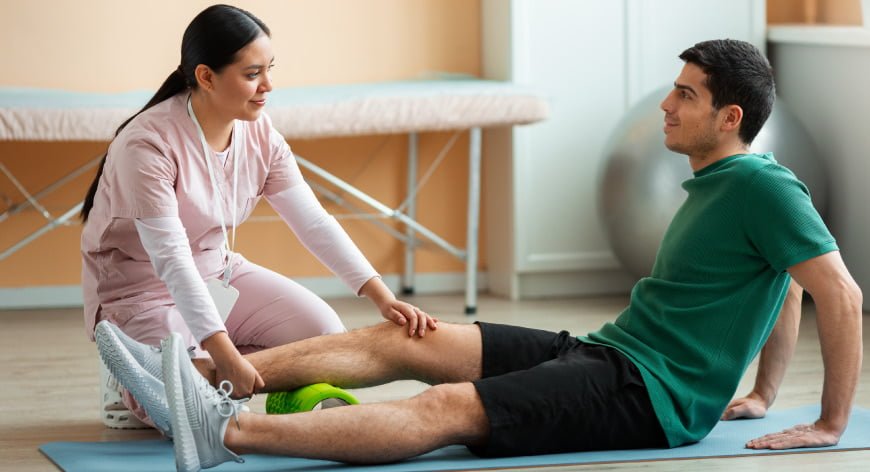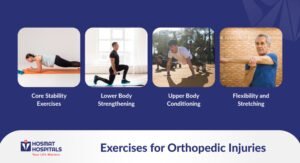
Maintaining an active lifestyle is essential for overall health, but without the right precautions, physical activity can sometimes lead to injuries, particularly to our musculoskeletal system—our muscles, bones, and joints. Whether you’re an athlete, a weekend warrior, or someone simply trying to stay fit, orthopedic injuries can be a serious setback. However, the good news is that many of these injuries can be prevented with a proper exercise routine. In this post, we will explore four effective exercises that can help bolster your body’s defences against orthopaedic injuries.
The Foundation of Orthopedic Injury Prevention
Before we dive into the exercises, let’s establish a fundamental understanding: prevention of orthopedic injuries starts with a combination of strengthening, flexibility, and stabilization exercises. These exercises help in improving the resilience and functionality of your musculoskeletal system, making it more adept at handling stress and reducing the risk of injuries.
4 Effective Exercises for Preventing Orthopedic Injuries
1. Core Stability Exercises
A strong core is pivotal for orthopedic health. It supports the spine, improves posture, and reduces the load on your lower back, thereby preventing back injuries.
-
Planks
Planks are a versatile and effective core strengthening exercise. They engage multiple muscle groups simultaneously without putting excessive strain on your spine or hips.
How to Do It: Start in a push-up position, but instead of resting on your hands, lower onto your forearms. Keep your body in a straight line from your head to your feet. Hold this position for as long as you can maintain proper form, aiming for increments of time as you improve.
-
Bird Dog
The Bird Dog exercise improves core stability and balance while enhancing coordination and spinal alignment.
How to Do It: Begin on your hands and knees, ensuring your hands are directly below your shoulders and your knees below your hips. Simultaneously extend your right arm forward and your left leg back. Hold for a moment, then return to the starting position and repeat on the opposite side.
2. Lower Body Strengthening
Strong lower body muscles support your joints and improve your balance, reducing the risk of falls and related injuries.
-
Squats
Squats are incredibly effective for strengthening the entire lower body and core, including the hips, glutes, quads, and hamstrings.
How to Do It: Position your feet so they are shoulder-width apart. Keeping your back straight, lower your body as if sitting in a chair until your thighs are parallel to the floor. Ensure your knees don’t go past your toes. Return to the starting position and repeat.
-
Lunges
Lunges are excellent for developing lower body strength and flexibility, particularly in the hip flexors, which are crucial for maintaining pelvic health.
How to Do It: Begin by standing upright, then take a step forward with one leg and descend until both knees are bent at approximately a 90-degree angle. Ensure that your front knee is directly above your ankle. Push back to the starting position and repeat on the other side.
3. Upper Body Conditioning
Strengthening the upper body can help prevent injuries by supporting joint health and improving bone density.
-
Push-Ups
Push-ups strengthen the shoulders, chest, and triceps, and also engage your core, offering a holistic upper-body workout.
How to Do It: Start in a plank position but with your hands placed slightly wider than shoulder-width. Lower your body until your chest almost touches the floor, then push yourself back up to the starting position.
-
Dumbbell Rows
This exercise targets the back muscles, which are essential for proper posture and spinal health.
How to Do It: Hold a dumbbell in one hand and, with a flat back, bend over at about a 45-degree angle. Pull the dumbbell straight up to the side of your chest, keeping your upper arm close to your side. Lower it back down and repeat. Switch sides after completing your set.
4. Flexibility and Stretching
Incorporating flexibility and stretching exercises into your routine can greatly reduce the risk of orthopedic injuries by improving the range of motion and decreasing muscle stiffness.
-
Hamstring Stretch
Tight hamstrings can often lead to lower back pain. This simple stretch can help maintain their flexibility, offering protection against back injuries.
How to Do It: Sit on the ground with one leg extended and the other bent so that the sole of your foot is against the opposite inner thigh. Lean forward from your hips and reach toward the toes of your extended leg. Hold for 20-30 seconds and switch legs.
-
Shoulder Stretch
Shoulder injuries are prevalent, but daily stretching can keep the muscles flexible and strong.
How to Do It: Bring one arm across your body and use the other arm to press it into your chest gently. You should feel a stretch in your shoulder. Hold for 20-30 seconds and switch arms.
Conclusion
Orthopedic injuries can be a barrier to leading an active and healthy lifestyle, but with the right precautionary measures, their risk can significantly reduce. Incorporating these four exercises into your routine can strengthen your musculoskeletal system, increase flexibility, and ensure your body is better equipped to handle physical stress without injury.
Remember, consistency is key to prevention. Make these exercises a regular part of your fitness regime, and you’ll not only be protecting yourself against potential orthopedic injuries but also improving your overall health and well-being. Whether you’re an experienced athlete or just starting on your fitness journey, these exercises provide a foundation for a strong, resilient body capable of withstanding the challenges of your active lifestyle. Stay safe, stay strong, and keep moving forward with confidence in your body’s ability to protect itself.
Ready to take the first step towards a healthier you? Consult with our orthopedic specialists at Hosmat Hospitals, the best orthopedic hospitals in Bangalore, to create a personalized exercise plan tailored to your needs and goals. Don’t wait until an injury sidelines you—start your journey to optimal orthopedic health today and embrace a life of strength, flexibility, and vitality. Your future self will thank you for it.
Disclaimer: This information is for educational purposes only and should not be interpreted as medical advice. Always consult with your healthcare professional before starting a new exercise program, especially if you have any pre-existing health conditions, including orthopedic conditions. They can help you design a safe and effective exercise routine that meets your individual needs.


